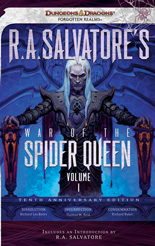War of the Spider Queen, Volume I
War of the Spider Queen is a series of epic fantasy novels written under R.A. Salvatore. A compilation of these novels has been published by Wizards of the Coast.
By Lawrence “darth_kwan_doh” Grabowski

War of the Spider Queen is a six book series written under the R.A. Salvatore brand. Although he didn’t write the books, he was involved in the brainstorming and editing process. Now, before anyone groans, there doesn’t seem to be any evidence of Mr. Salvatore’s most famous, often copied, and often reviled character.
The Drow of Menzoberranzan are experiencing a great religious silence. Lolth is no longer granting her priestesses spells or responding to any attempts to communicate with her. Over the course of the first book, the main characters are brought together to figure out what’s happened.
It doesn’t begin that way however. Initially Ryld and Pharaun, masters of the Drow fighter and wizard academies, are sent on a mission to investigate the disappearance of a large number of males. During the first book we learn that the disappearing males are part of a plot to overthrow the matron mothers of Menzoberranzan, headed by a group of rogue males and their mysterious Underdark ally.
In the second book, the protagonists travel to Ched Nasad to investigate Lolth’s disappearance as well as forcibly recover trade goods jointly owned by house Baenre, of Menzoberranzan, and house Melarn, of Ched Nasad. Stuff happens, including the introduction of a half-succubus, but the most entertaining part of the book is a city-wide battle that occupies the majority of the pages.
The third book picks up after the protagonists escape Ched Nasad, their party now size seven. Arriving on the surface world, they track down a priest of a heretical, depending on your point of view, Drow religious sect. After making contact with the priest they journey to the Demonweb Pits in an attempt to contact Lolth directly. This novel also begins to detail the Jaezred Chaulssin, a mysterious organization inciting the powers that be in the Underdark against the Drow, specifically Menzoberranzan.
The main characters each fill out one of the four basic D&D archetypes: warrior, rogue, cleric, and mage:
Ryld: A master of Melee-Magthere, the Menzoberranzan warrior academy, Ryld is the group’s fighter. He is unusual because he clawed his way up from the slums of the city to a position of great importance. He fights wearing a suit of plate mail, rather than the typical Drow chainmail. Additionally, he wields a large two-handed sword called Splitter. Generally his role is to solve problems with violence.
Jeggred: Closer to a barbarian than a fighter, Jeggred is an angry half-demon. In a sense, he is the barometer for how in accord with Lolth’s religion an individual is acting. He is loyal to a fault to Lolth’s religion generally and Quenthel specifically, since she is the highest ranking priestess in the group and his blood relative.
Valas: A mercenary commoner of Bregan D’aerthe, Valas is the group’s rogue. Being a commoner, he lacks the levitation powers of the noble-born Drow, something that is occasionally used as a complication. He is much better traveled than the other characters and has a suite of magical items and obscure lore to show for it.
Quenthel: Like all the clerics of Menzoberranzan, Quenthel has been unable to speak with Lolth and prepare spells since before the beginning of the series. She carries the iconic snake whip of the Drow priestess, although the snakes of her whip are more intelligent than normal. She attempts to lead the party in the same dictatorial style all priestesses used when they had the divine power of Lolth at their command, but she is often forced to concede that others, particularly Pharaun, have worthwhile contributions to make to a given situation.
Pharaun: The group’s wizard. He often ends up as the de facto leader, or at least decision maker, because he has the knowledge to plan effectively. He is intelligent and witty compared to typical Drow, often lamenting the humorless nature of his race. His flippant demeanor brings him into conflict with Quenthel, who despises his irreverent tendencies.
I would like to touch on what I didn’t like before going into what I did. My biggest complaint about the first volume has to be what seems to me to be Drow fan service. Over the course of the first three books there are instances of, or implied instances of, incest, lesbianism, and a half-succubus sleeping with several other characters. Every time I read a scene that included one of the above I just had to roll my eyes. I felt those sections were unnecessary and the story could have been moved along in other, less fan servicey, ways.
There were also a few typos.
The series deals with some themes that I haven’t encountered in books about Drow before, friendship for example. Prior to my reading of this series, all Drow friendships seemed more like networking relationships that had the potential to end when one person killed the other. That is to say, the participants behaved amiably towards each other for mutual gain while secretly planning the other’s downfall.
Ryld and Pharaun start the series with what seems to the reader to be a genuine friendship. They watch each other’s backs in dangerous situations, they make jokes together, and they exasperate each other on occasion. Between Ryld’s quiet, unassuming nature and Pharaun’s dandy pride an entertaining dynamic is created. This changes while fleeing from the stronghold of the rogue males; Pharaun abandons Ryld to escape enemies chasing them both. As is necessary with a group of protagonists on a quest to save their little corner of the world, Pharaun and Ryld eventually are reunited. By all outward appearances, they are friends still. Pharaun apologizes for abandoning Ryld and Ryld claims to not hold a grudge. Internally however, Pharaun confides that he can no longer read Ryld’s intentions and briefly laments the loss of their friendship.
I was happy that the topic of friendship in Drow society was broached (there are some similar topics brought up in the second half of the series but I won’t spoil it). For a long time I’ve wondered how the Drow manage to keep a society together where you and your drinking buddy are just waiting for the other to get drunk enough so one of you can kill the other and take their stuff.
One might argue that the hierarchy provided by the Lolth keeps things together, but throughout the first half of the series we see that without their goddess’ blessing, the power of the matrons is significantly reduced as the religious stability of Drow society is called into question. Furthermore, when isolated from the society as a whole, their power is further reduced and they are forced to depend on their belligerent nature to keep those beneath them inline.
I was pleasantly surprised by the first half of the War of the Spider Queen. I was expecting it to be a withered leaf clinging onto a distant branch of the Forgotten Realms tree. Instead I got what, in my opinion, is an interesting story that happens to be set in Forgotten Realms, rather than a book set in Forgotten Realms with a plot of uncertain quality. The characters are believable, even going so far as to address parts of the setting I found unrealistic. The battle scenes were cool. I liked that they integrated other races from the Underdark into the plot. If you are into the whole Drow lesbian thing, there’s some of that too. I am excited to read the next set of books in the series and I would recommend War of the Spider Queen to fans of Forgotten Realms and fans of the fantasy genre in general.


